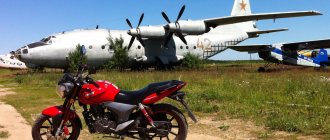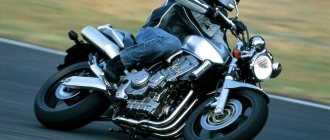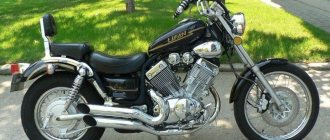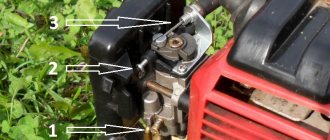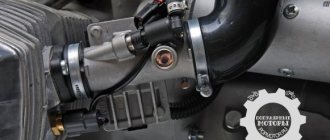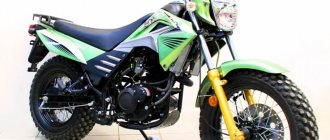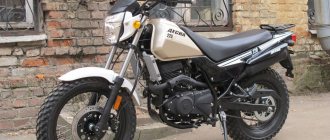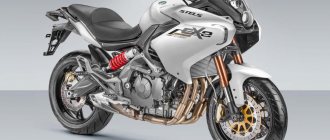A utilitarian motorcycle for every day
Of course, the Japanese motorcycle monsters have their enormous experience and reputation on their side, but China is the world’s main manufacturer of small-capacity bikes, so the Stels Flame 200 motorcycle performs quite confidently in this field. Lightweight, cheap, reliable and economical - it is exactly what a first bike should be. And after the introduction of subcategories A and A1 in driver’s licenses, where “A1” means motorcycles with an engine up to 125 cubic centimeters, Flame 200 began to be purchased en masse by many motorcycle schools, because it can legally teach straight to category A, and on the super popular YBR- 125 - only on the A1, although these bikes actually differ very little, and don’t be confused by the number “200” in the name.
The Chinese have already become skilled in the production of budget motorcycles, successfully installing the same engines, gearboxes and suspension elements on a variety of models, sometimes even produced at factories of different manufacturers. This is for the better - such a wealth of experience allows them to make inexpensive, but quite high-quality bikes for every day, and the Stealth Flame 200 motorcycle is an excellent confirmation of this.
MAIN TECHNICAL POINTS ON STELS FLAME 200 TRANSMISSION AND CONTROL
2)Transmission and control
Good day! This block of posts is dedicated to the main technical problems, shortcomings and features of the Stels Flame 200 motorcycle. I have already written a little background in the description of my motorcycle. Year of manufacture 2013, purchased in August 2016 with a mileage of 13k, currently the mileage is 25k. I already told you about the engine, let's move on) Some technical data:
Wheels -17,
disc brakes,
telescopic front fork, gas-oil, inverted type,
rear shock absorbers with extensions,
chain 428, 128 links,
seat height 770 mm.
steel frame, welded, tubular, open type
Let's start with the wheels.
Casting on Flame is quite heavy, the metal from which the casting is made is quite brittle and brittle, and in an accident, usually, if the wheel suffers, bends, or something else, it is not boiled, not rolled, but simply thrown out and a new one installed. In theory, if you put lighter wheels, it will drive completely differently, but I went the opposite way. Having driven on original tires with a mileage of 14-15k kilometers, 700-1000, I realized that I have never seen anything harder than wood. It was just terrible, every time I entered a turn with caution, afraid of flying somewhere, if I was lucky, into the bushes. It was urgently decided to change the tires. The choice fell on Shinko e700 4.60-17. According to the description, universal tires, 50/50 - asphalt/soil. Put. First impressions are simply incredible. The motorcycle now has traction. The motorcycle began to be controlled, turned, and put into turns. I'm happy. No, honestly, I was happy as an elephant, because it’s just earth and sky. The grip is also excellent off the asphalt. In general, the tires are truly universal: asphalt, soft ground, hard ground, stones, clay, sand, no problem for it. Yes, given the class of the motorcycle, maybe not everywhere, and not entirely comfortable, but I can always get out of any “shit” wherever I go. The only problem with these tires is that they are quite high, and I had to think about how to raise the front wing, because the wheel wouldn’t fit :/ However, this issue was resolved long ago, and the wing was installed in its rightful place
Brakes.
Well…. they exist, let's put it this way. Especially when you're traveling alone. The front caliper is 4-piston, opposed, and is completely copied from the Brembo of the shaggy year, for which there are no longer branded brake pads. But I would buy it, since my relatives, in my opinion, will do a bad job. In particular, after replacing the tires, the brakes “appeared.” The situation with the rear caliper is similar, only 2-piston, also opposed, also licked from the Brembo of the shaggy years, you can find branded pads for it, but they will cost a little more than a wing from a Boeing, and the rear brake also “appeared” after replacing the tires. The brake fluid lines in the stock are rubber, naturally, by 25 kilometers they were already quite worn out, and neither I nor any of the previous owners, I am sure of this, changed the brake fluid. Unfortunately, I couldn’t find any experience using reinforced brake hoses on this motorcycle, so I’ll have to be a pioneer in this matter. Projection: 2000 wooden ones for fittings and brakes, 2 hours for pumping, it doesn’t seem complicated. In the meantime, the issue of brakes remains open, because I often drive with a passenger, and there are few brakes.
Suspension.
Well... it’s like with the brakes, it seems to be there, but that’s not for sure. The whole absurdity lies in the fact that when you sit on a motorcycle and compress and release the suspension in place, you can feel its movement, and not a small one. But as soon as you get underway and “jump”, excuse me, drive along our “wonderful” roads, you realize that you have just been tricked, everything was just so soft, and now you are driving 30, and sometimes they shake like on a hard enduro track . In general, change the oil in the front fork to the thinnest one, to soften it, and the rear shock absorbers are naturally woody. Either oak or ash. The girl often complains that from the slightest hole the entire impulse is transferred to the passenger seat, but then you understand. And again, after changing the tires on the motorcycle, the suspension improved its quality at least a little. I think this is due, after all, to the small height of the tires. Now focus. Remember the paving stones on the tram tracks. Do you remember? Well done. I fly on it almost every day when I go home, but the shaking is still minimal, even though the paving stones are old and rolled, they are still paving stones. In short, the secret of the suspension remained undiscovered, because after replacing the oil seal and oil, respectively, in the left fork, the fork became softer in place, more travel appeared, but directly in the direction of travel, the shock absorption remained the same.
Chain and stars
The original chain and sprockets were made of plasticine and tightened them every 100-200 kilometers. I installed a DID oil seal chain, the gold one, new JT sprockets, and I don’t know any grief. Regarding cleaning and lubrication. I perform this procedure on average at intervals of 300 to 700 km. in different ways, in general, but at 700 km and above, this must be done. As for setting the drive stars for speed or thrust, let’s just say that the grave will fix the hunchback. Don’t suffer and don’t try, if you need an increase of 10-15 km/h maximum, then go ahead, it’s not worth bothering with. For example, I have long come to terms with the operating speed ranges of this motorcycle, everything suits me, but on the other hand, it’s for the best - I won’t fly.
Control
All those who came across this motorcycle while passing the exam at the traffic police, I sympathize with you, you got a stock one. The whole problem is in the handling of this motorcycle on the surface: the tires and the steering wheel. I changed the steering wheel almost immediately, the tires a little later. Believe me, these are 2 different motorcycles. As with rubber - earth and sky. It’s clear that I made it for myself, but those rare occasions when I gave it to someone I knew for a ride, usually ended with the phrase: “It drives great” and stuff like that. With the new straight steering wheel, I began to feel more confident, I began to turn better, and the motorcycle as a whole became more responsive. Taken together with the configuration of my particular motorcycle, it behaves predictably and that’s the main thing. The flame is light, I would say even very light. At speeds above 80 it already starts to throw a little.
That’s all for now, if I remember anything I’ll be sure to write)
Tags
- stealth
- stealth flame
- stealth flame 200
- stels
- stels flame
- stels flame 200
- 164fml
Characteristics and parameters
From a design point of view, the Flame 200 is absolutely nothing special - it is the most budget motorcycle. Steel frame, ancient 13 HP 1 cylinder air cooled engine, 5 speed transmission, carburetor and disc brakes front and rear. Thanks to its moderate seat height and dry weight of only 132 kg, the Stels Flame 200 motorcycle is controlled almost by an effort of thought, which is very valuable for a beginner who does not feel too confident on the road.
Of course, there is no need to talk about any impressive dynamics, but let’s not forget that we are talking about a very budget motorcycle, and not a sportbike. And the Stealth Flame 200 copes perfectly with the task of “driving every day” - a kind of workhorse, tenacious and not too gluttonous.
Among motorcyclists, and even in everyday life, there is an opinion that things made in China are not reliable, and in general it is better to avoid them, especially motorcycles. Is it so? In this post I will talk about my experience with Chinese technology. This is my personal subjective opinion, which emerged as a result of practice, and is aimed at warning against some problems during purchase and operation and, in general, for interest. The story will be about my motorcycle QJ Stels Flame 200. About what I encountered during two years of use, how much money was spent on repairs and maintenance, and what this motorcycle is all about. In the final, I will try to compare the list of breakdowns of this motorcycle with the Honda CBR 919RR FireBlade motorcycle over two years of their parallel operation.
In the last article, I wrote about the fact that I didn’t buy the motorcycle new, and also about the crooked hands of the previous owner. Today I will tell you more about this. The first thing I noticed when buying a motorcycle was oil leaks on the engine and a piece of gasket that was sticking out from under the block. Everything is very clear: the owner tightened all the screws by hand after purchase. I'll tell you a little more about this. Among the owners of Chinese motorcycles, there is one rule, invented by someone: if you buy a motorcycle, check that the bolts are tight. This problem can be encountered, for example, on Stels Flex. They are assembled here in Russia, and the degree of tightening of the bolts depends on the conscientiousness and sobriety of a certain Uncle Vasya. And if you ignore this point, you can lose a couple of bolts from the muffler. Therefore, everyone is advised to check the tightness of the bolts. That's right, it's the right thing to do. But maybe we shouldn’t take everything so literally? Check the tightness of the bolts, rather than take a wrench and tighten all the bolts on your new bike as far as it takes. Stels Flame has a different policy; they are produced and assembled by (who tried to read?) or simply QJ Motor. It is the largest manufacturer of motor vehicles in China. The annual capacity is 1,200,000 units of equipment, which is produced in premises occupying 670,000 square meters of land. And these guys' assets are $450,000,000. And there’s already an obsessive feeling that this doesn’t look much like a basement with Chinese teenagers assembling an engine on their knees after school, right? But it was these guys who bought the Italian company Benelli, which gave a significant technological leap in production. But let's get back to the bolts. You still need to check the tightness, even though the equipment is not assembled here. And if you suddenly decide to tighten the bolts on the engine, then what do we remember about the torque wrench? Exactly. As Uncle Ben said: the greater the power, the greater the responsibility. So, what do we have after the intervention of the previous owner of the motorcycle in terms of tightening the bolts: 1. The gasket on the engine was squeezed out, and squeezed out so much that it tore (here in this place, photo after repair);
2. The front brake lever was pulled, which caused the brakes to jam, and the user didn’t think of turning them back, he simply stopped using the front brake, which resulted in the following: he erased the rear pads, couldn’t buy new ones (or didn’t even think about it) about this), so I braked metal on metal, there is a recess on the brake disc about two millimeters deep;
3. The bolt on the starter was tightened (decorative, because I didn’t find any functionality in it), as a result, the ear was broken off along with a piece of the housing due to vibration at rpm; It’s a very difficult place to photograph, so I’ll attach it later if I can do it well. 4. The steering wheel was overtightened, which made the steering wheel difficult to turn, and when braking, the motorcycle dangled in the area of the front wheel (how is it connected? I don’t know. But when I loosened the nut, the problem disappeared). Chinese quality? - I don't think. Lack of intelligence - yes. And there’s only so much you can show for quality. Only for the starter alloy, it would have been of better quality - it would have withstood more time under such a load (and it could have been welded, but this one cannot be welded at all). All this could have been avoided simply by not doing too much. Next, the speedometer gearbox was eaten. I have no questions here, consumable. I bought a new one, installed it, everything is fine. The issue price is 1200. Well, the last thing I remember is a crack on the tachometer window. He says that grandma caught it with a saucepan. No water gets in, there is no moisture inside, I don’t even worry. The decor, after all, does not affect the aerodynamics. These are hereditary injuries that I struggled with later. My repairs began with the chain. The stock chain stretched out very quickly, even after three years of use... For some time I was looking for a chain for this motorcycle, but there was no such chain in our stores (428, in my opinion), so I had to go to collective farms. Without thinking twice, I installed the ant chain; as it turned out, it was quite suitable, even in length. During the replacement, I noticed an unpleasant thing: the chain tensioner is a bolt that sticks out from the pendulum and is tightened with two nuts. And, on the left side, just under such a bolt, the thread was eaten away. A piece of durable plastic straw solved the problem.
Two years have passed since replacing the chain and I have only tightened the chain once. It is possible that the ant's chain is designed for a higher load, so it does not stretch as much as the original one. At least I think so. There were no problems with the stars, which surprised me. Quite harsh rural use and infrequent maintenance (if the chain was washed at all) could simply destroy them, but wear is generally insignificant. I myself try to service the chain every fifteen hundred kilometers. The carburetor is a completely different story. From the very beginning, even upon purchase, the owner told us to turn off the tap, otherwise gasoline would flow. Naturally, this state of affairs did not suit me. On the side step, gasoline began to actively ooze through the overflow. A liter of gasoline flowed out overnight and the same amount evaporated while the droplet flew. Naturally, I made a big mistake. To begin with, I bent the bar that lowers the needle - the gasoline stopped flowing... for an hour, and then I went back to the old way. I changed the needle and it helped for a couple of days. Plus, the revs froze. Oleg and I climbed into this hellish carburetor about six times, and then I gave up and ordered a PZ30 from China (it was installed in stock on flames after 2013, as far as I know. Before that they installed 28). The carburetor took a long time, a very long time. In addition, I didn’t know how to ask the Chinese some points with the carburetor, which I saw in the picture, but didn’t know what it was. I tried to ask in Russian English what kind of lever this was, and they answered me in Chinese English that “mine is yours, I don’t understand.” The carburetor has arrived. And I realized that it was a lever for the cable that controls the accelerator pump. The funny thing is that from the gas handle to this carburetor there is a forked cable, but on my model there is a single cable. Having looked for such a forked cable in the markets, and being a little stunned by the cost (half the size of a carburetor), I spat and installed it as is. In fact, there is only one problem because of this: on a poorly warmed-up engine, a sharp opening of the throttle accelerates the engine with a second delay or stalls altogether. I promised myself to solve this issue by the next season. The next thing that went wrong was the rear shock absorber. The bolt that attaches it to the frame simply split in half and separated with a pop, like the first stage of a Soyuz rocket. This happened while accelerating from a traffic light. I didn’t immediately understand what had happened, well, bang and bang, I looked around in search of the source of the sound, couldn’t find it, and went to the garage. Only later did I realize that one shock absorber was simply lying on the plastic. I solved this problem in two hours. I drilled a hole in the frame, cut a thread and screwed a powerful Soviet bolt into it. The difficulty was that the standard shock absorber mount is such that a threaded pin (monolithic or welded, I don’t know) comes out of the frame, the shock absorber is placed on it and screwed on top with a beautiful nut.
This nut was ejected along with what was sticking out of the frame. I don’t know what the frame is made of, but I drilled it for a very long time. In this place or the whole frame is like this - I don’t know, but it is not hollow. I lost one drill and a couple of taps while I was fighting it. But I still won, and I had no more problems with it. I don’t know the reason for this behavior of the standard mount. Quality? Why didn’t the second one behave like that then? The question remains open. This was the biggest pain.
I dealt with the engine, or rather the torn gasket and oozing oil, cheaply and cheerfully. I disassembled the engine down to this gasket, bought a piece of paronite for pennies, cut out the desired shape, a little sealant and the problem went away. Why didn't the previous owner do this right away? I don't care. There were no more problems with the engine (valve adjustment does not count). At the moment, the motorcycle's mileage is already approaching 25,000. Regular maintenance is all. So far there have been no problems with the gearbox or clutch. The gears do not fly out, there are no crunches, no knocks, and the clutch does not slip. Even though from second and higher I usually switch with quickshift (yes, there are no problems with this at all on this motorcycle). The fuel gauge doesn't work, but I don't really need it, so I haven't gone into it yet. I planned this for this winter. Well, that's all. By and large, I fixed what the previous owner had screwed up and rode around without any problems. Last season I had an accident. Already in late autumn, around the same time as now, I was driving home. The weather was not very cold and quite dry. It was evening and dark outside. Since my battery died a couple of weeks before, I was driving without it, so my light (already not light) was quite dim. I wasn’t going to buy a new battery, because I didn’t want to ride on it for a week and then have it sit through the winter. I decided to buy it at the beginning of next season. Naturally, I didn’t drive more than 70, even though the road was well lit. I'm driving on a four-lane road, two lanes on each side of the road, separated by a double solid road. I'm driving in the left lane. Ahead of me in the right lane, twenty to thirty meters away, is a car. We walk at approximately the same speed and at one moment he passes the exit from the courtyards, and right after him a car emerges from there. He crosses the first lane, begins to cross the second, and cuts them strictly perpendicularly (he was going to turn left through a double solid one). Only a few seconds passed from the moment I saw him to the collision, but a lot happened. I understand that he is breaking the rules and blocking my lane, I press on the signal, but I have almost no sound (there is no battery). I depress the clutch, apply the rear brake to load up the suspension, and then squeeze the juice out of the front brake. The rear wheel starts to lift, and I'm squealing on the verge of a stoppie. I look at the driver, he looks at me and continues driving. I drive straight to his door. I don’t know how much distance was left to the car, but I realized that I wouldn’t have time to stop. I release the brakes, twist the steering wheel to the right and lay down the motorcycle to pass him in front (he has already pressed the brakes). The motorcycle tilts to the left, takes the desired path and I start to shift it to the right and I’m probably missing half a meter. I hit his bumper with the exhaust pipe. The motorcycle flies into the oncoming traffic, tumbling, and I fly through the hood, feet up. A loud bang in the helmet notified me that I had touched the surface of the planet. After riding a little on my head and shoulder, I stopped. I get up after a couple of seconds, run to the motorcycle and turn it off. I look up, and my opponent is already a hundred meters away and continues to move away from the scene of the accident (well, that’s right, the deprivation of rights is one hundred percent, and even I flew over the hood so grandiosely that it’s not a fact that I survived). I pick up the motorcycle, roll it to the side of the road and sit on the curb. No one stopped, they just honked a couple of times to tell me to quickly get out of the way. Having recovered a little from the shock, I decided to still inspect the motorcycle. I was surprised. Considering that the bike had tumbled, I was expecting a crash. But... A broken mirror, a broken brake handle, a slightly dented can with remnants of the offender's paint, a small dent on the tank, the size of a two-ruble coin, a slightly bent footrest and a couple of scratches on the front. All. Even the turn signal is intact. The stock steering wheel weight looks like it was made from a piece of Superman's ass, because all the paint has peeled off of it, there aren't even any scratches. And, holy gear, there are no scratches on me either.
Now why am I doing all this? Repair:
New mirrors, a pair 754 rubles New handles and weights 591 rubles (I’ve been wanting to change them for a long time, just on the sly) Brake machine with lever 1100 rubles Clutch lever with mount and sensors 517 rubles (changed so that the color of the lever was the same as the brake) We aligned the can and painted it ourselves.
Such an expensive repair, such a fragile Chinese motorcycle. These are all the problems that I have encountered as a result of two years of owning this motorcycle. From tuning: I recently installed forward flow (Chinese, of course). I chose for a long time, looked closely and was not mistaken; I ordered what I needed. By doing this, I greatly choked the engine, I felt it immediately while driving. In addition, the old exhaust weighed almost seven kilograms, and this one weighs two kilograms. Well, the sound... I can already recommend it just because of the sound.
I also installed additional light.
Regarding operation. I don't just ride a motorcycle to and from work. I ride quite often for fun. Already in the first season I managed to travel a little on short distances.
This year I have already reeled in 3000 just outside the city.
I have never seen any breakdowns on the road, unlike a Honda, which I even once towed (yes, a motorcycle with a motorcycle).
Now a little comparison, as I promised at the beginning. Let us immediately understand and remember that I am not trying to compare a Chinese motorcycle and the quality of its workmanship with a Japanese one. I will only compare the number of breakdowns and our hard-earned money spent on repairs. Honda prices will be approximate.
So let's get started. QJ Stels Flame 200, produced in 2013. Spent on repairs and modernization: 2962 rubles for restoration after an accident 1343 rubles speedometer gearbox 2499 rubles forward flow 445 rubles additional light 1553 new carburetor 550 rubles new chain. 100 rubles piece of paranit. 100 petrol hose. Total: 9552 rubles.
Honda CBR919RR FireBlade 1997. Mask with headlights - 3500 rub. Welding work - 1000 rub. Stickers - 2000 rub. Charging relay x2 — 2000 rub. Electronic speedometer - 1200 rub. Temperature sensor - 1500 rub. Tachometer - 3500 rub. Plastic - about 15,000 rubles. Contract engine (I’ll tell you separately why this happened) - 50,000 rubles. Light bulbs, hoses, screws, wires, coolers - 4000-6000 rubles. Paints - about 5000 rub. Chain locks - about 1000 rub. Headlight - 2500 rub. Young dermantine leather - 500 rub.
Total: we are close to the mark of 140,000 rubles. This is just what I remember, not counting the "about costs". And we still have a lot of repairs ahead, the bill will continue to grow. This takes into account that we do our own repairs, painting and everything connected with it. We make some spare parts ourselves, and there are quite a few of them. And it’s good that we don’t have to redo it after ourselves, otherwise we wouldn’t have gotten out of there at all. Now a little about fuel consumption. Let me remind you that we are comparing a steamship with a paraglider, and this is for your interest. Not counting the reserve - on the Stealth there are 15 liters per 400 kilometers. On a Honda, consumption is approximately 13.5 per hundred. That is, to get to work on a flame costs 9 rubles one way, on a Honda 32 rubles, on a minibus 24. The numbers are approximate and rather rough, and depend on the driving style, except for the minibus. But expense is expense, and repairs are repairs. Most of the costs for the Honda are again the fault of the previous owners, because you saw in what condition it came to us in my last post. I will separately write an article about Honda, what it was and what it has become now, I think it will be interesting.
When people ask me why a Chinese man and not an elderly Japanese man, I answer simply - the economic component. Convenience, class of motorcycle, speed and dynamic performance, reliability, yes, yes, yes. We hear this every day from different sides and we all have our own opinions. I have my own opinion: get a new motorcycle. Chinese, Japanese, Italian, Bavarian - parallelepiped. Look at your finances and your preferences, but take a new motorcycle if possible. Now we are repairing motorcycles and we just see and hear about the previous owners. Also, keep an eye on your motorcycle. Motorcycles are like that - they love care and courtship. Take care of yourself and your motorcycles. Good luck on the roads!..
Advantages and disadvantages of the Chinese small-capacity model
- + Affordable price - in this segment this is undoubtedly one of the main advantages.
- + Inexpensive consumables and spare parts, which are always available at Stels dealers.
- + Gasoline consumption is about 3 liters per 100 km, which, in combination with a 17-liter tank, gives the Stels Flame 200 motorcycle a huge power reserve. If you decide to go on a trip on this bike, you will appreciate this fact.
- + Effective brakes by budget class standards.
- + The most simplified and therefore reliable design.
- — Low maximum speed - about 120 km/h.
- — Weak traction at high speeds.
- — If there is a passenger or large cargo, the dynamics of the bike noticeably sags.
Reviews from real owners
For my first bike, I chose something cheap and not too powerful, so that it wouldn’t provoke me, and it would be scary to get on a big bike right away. I bought it in the store https://stelscenter52.ru/catalog/mototsikly/ Stealth Flame 200, the reviews about it are normal. I didn’t regret it - the moped is suitable for practicing skills and gaining riding experience. Only for me, with my size, it’s cramped, my back starts to ache after a couple of hours, but when I dare to go on a long-distance trip, I’ll sell the Stealth and buy something more powerful. Alena, Yaroslavl, Stels Flame 200 '2015.
At first I wanted to take Yobrik 125, then I came across Flame’s review, became interested, and ended up taking it. I didn’t do any tuning; I don’t see any point in investing in a budget motorcycle. I pour 92 gasoline, I drive every day for work, sometimes I cover a thousand kilometers in a week. Buzzing, eating, rushing. A normal spender for your money. Alexander, Vladimir, Stels Flame '2016.
An ordinary cheap motorcycle, of which there are many. After the purchase (I bought a used one), I plugged a more powerful lamp into the headlight and installed a reinforced generator (bought on Aliexpress), and hung music from the same place on the steering wheel. The consumption has never been more than 3.5 liters; the cruiser handles 110 km/h normally. I got tired of it after a month, the dynamics are not enough, and you won’t be able to go long distances on it, but I will drive it until I save up for 600 cubic meters. Igor, Chelyabinsk, Stels Flame 200 '2014.
Main competitors
- The YBR 125 motorcycle is an incredibly popular motorcycle, inexpensive and ubiquitous on the roads. There is also a 250 cc modification, but it has never been officially sold in Russia. It’s also an excellent choice, but if you decide to buy a YBR, you’ll have to buy a used bike, or prepare a slightly larger amount than what you’ll need to buy a Flame 200.
- The Honda CB 125 is also a great bike, but it entered the market too late when Yamaha already reigned supreme in the budget segment. Its technical characteristics are similar to the Stealth Flame 200, but the price is slightly higher. But this is Honda!
Specifications
| Maximum engine power: | 13.1 hp at 7500 rpm HP |
| Torque: | 13.9 N•m at 5500 rpm Nm |
| Working volume: | 197 cm3 |
| Motor type (cylinder arrangement, number of strokes): | |
| Number of valves: | |
| Intake type (Injector / Carburetor): | |
| Bore and stroke: | |
| Starting system (Electric starter, kick starter): | |
| Maximum speed in km/h: | 120 km/h |
| Cooling system: | Air |
| Transmission (gearbox): | 5 |
| Clutch (Dry / Wet): | |
| Drive unit: | Chain |
| Frame: | Steel tubular |
| Chassis | |
| Suspension (front/rear travel): | |
| Brakes (Front/Rear): | |
| Wheels / Tires / Rubber: | |
| Dimensions and weight | |
| Dimensions (Length / Width): | |
| Seat height: | |
| Ground clearance: | |
| Curb weight: | |
| Wheelbase: | 1360 mm |
| Weight: | 132 kg |
| Fuel tank capacity: | 17 l. |
| Battery capacity: | |
| Year of release: | |
| Country of Origin: |
Stels Flame 200: for beginners and lovers of leisurely driving
Stels Flame 200 is a representative of the Chinese automobile industry, an ideal motorcycle for city roads, which is perfect for both beginners and experienced bikers. It is assembled in Russia from Chinese components.
The history of the Stels Flame motorcycle dates back to 2011. Three years later, a modified model of the bike appeared on the market, with a new carburetor built into it. The motorcycle also changed its appearance to a new color with a fashionable inscription on the tank, the material of the driver and passenger seats.
The characteristics of the Stels Flame 200 are very close to its closest competitor, the Yamaha YBR 125. But the Chinese motorcycle has wider wheels, making it more stable on the road, has a more stylish design and is much cheaper than its counterpart.
According to reviews from the owners of this motorcycle, it has a number of disadvantages, namely:
- very mediocre build;
- there are irregularities on the wheels, which, however, are easily eliminated;
- Immediately after purchase, the drive chain must be replaced.
In general, comments regarding Stealth Frame are positive. Those who have already given it a test drive note the following features:
- very affordable price in relation to the parameters;
- extraordinary design;
- comfortable fit;
- minimum fuel consumption of 3-4 liters per 100 km;
- stylish electronic panel.
The motorcycle has average characteristics, so you don’t need to place high hopes on it in terms of dynamics and speed. But at the same time, it copes well with driving around the city, so it can become an excellent companion for every day.
The engine is standard, does not produce vibration, and can be started using a starter or kickstarter. The maximum speed that Stels Flame develops is no more than 100 km/h. Perfect for beginners and lovers of quiet walks.
The design of the bike is quite classic. Repairing such a vehicle is possible for anyone who has an idea about the structure of Soviet motorcycles. But it is better to carry out planned and complex repairs at a service station. You can also order spare parts directly from China.
Here's what the happy owners of this “iron horse” say about Stealth Flame 200:
“Excellent quality, despite its Chinese origin. True, the chain stretched literally after 7000 km. In addition, the carburetor acts up and freezes at medium speeds. I had to change the light bulb, because the light bulb in the basic configuration is only 35 watts, and this is very little for driving in the dark.”
“I’m happy with the bike, everything is cool! The cooling works like a Swiss watch: I overheated it and cooled it sharply, there were no problems. Someone wrote here that plastic breaks, so if you don’t know how to drive a motorcycle carefully, then it’s your fault, not the manufacturer’s. Another plus is the low price in relation to quality. The design is also a plus."
“My mileage on this bike is about 300 km. After the first hundred, the chain stretched greatly. After some time, I changed the oil and realized that I should have done this earlier, since my oil is more like water. Otherwise everything is pretty predictable. It starts from the starter with half a turn, sometimes I can give it a kick in the form of gas. It drives well on a straight road, but at intersections there are inconveniences with braking. Overall, I'm very pleased with the motorcycle. It suits me personally.”
“I drove it more than 1000 km. Still intact! I don’t accelerate very fast on it, at most 6000 rpm, because even though it’s Chinese, it’s somehow a pity to kill it right away. The chain stretches terribly, I have already tightened it several times. Clutch discs stick together. I’ll continue to see what happens to Flame and whether it’s even worth a major overhaul.”
Stels Flame 200 has the following technical characteristics:
| Frame | Steel, tubular, welded |
| Starter | 1 cylinder, 4 stroke |
| Working volume | 197 cc cm |
| Cooling | Air |
| Inlet | Carburetor |
| MAX power | 11.3 hp |
| MAX torque | 13.9 Nm |
| checkpoint | Mechanical, 5 stages |
| Drive unit | Chain |
| Front brake | 1 disc, hydraulic |
| Rear brake | 1 disc, hydraulic |
| Front suspension | Telescopic fork, inverted |
| Rear suspension | Pendulum, two shock absorbers |
| LxWxH, mm | 2130x770x1120 |
| Wheelbase | 1360 mm |
| MAX speed | 170 km/h |
| Tank capacity | 17 l |
| Weight | 132 kg |
